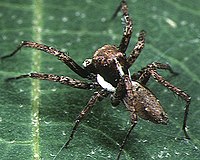
Photo from wikipedia
The feats of arthropods, and of the well-studied insects and crustaceans in particular, have fascinated scientists and laymen alike for centuries. Arthropods show a diverse repertoire of cognitive feats, of… Click to show full abstract
The feats of arthropods, and of the well-studied insects and crustaceans in particular, have fascinated scientists and laymen alike for centuries. Arthropods show a diverse repertoire of cognitive feats, of often unexpected sophistication. Despite their smaller brains and resulting lower neuronal capacity, the cognitive abilities of arthropods are comparable to, or may even exceed, those of vertebrates, depending on the species compared. Miniature brains often provide parsimonious but smart solutions for complex behaviours or ecologically relevant problems. This makes arthropods inspiring subjects for basic research, bionics, and robotics. Investigations of arthropod spatial cognition have originally concentrated on the honeybee, an animal domesticated for several thousand years. Bees are easy to keep and handle, making this species amenable to experimental study. However, there are an estimated 5–10 million arthropod species worldwide, with a broad diversity of lifestyles, ecology, and cognitive abilities. This high diversity provides ample opportunity for comparative analyses. Comparative study, rather than focusing on single model species, is well suited to scrutinise the link between ecological niche, lifestyle, and cognitive competence. It also allows the discovery of general concepts that are transferable between distantly related groups of organisms. With species diversity and a comparative approach in mind, this special issue compiles four review articles and ten original research reports from a spectrum of arthropod species. These contributions range from the well-studied hymenopterans, and ants in particular, to chelicerates and crustaceans. They thus present a broad spectrum of glimpses into current research on arthropod spatial cognition, and together they cogently emphasise the merits of research into arthropod cognitive achievements.
Journal Title: Animal Cognition
Year Published: 2020
Link to full text (if available)
Share on Social Media: Sign Up to like & get
recommendations!